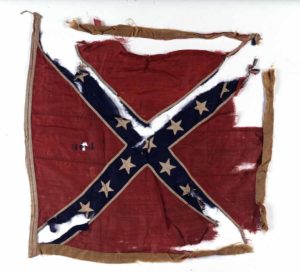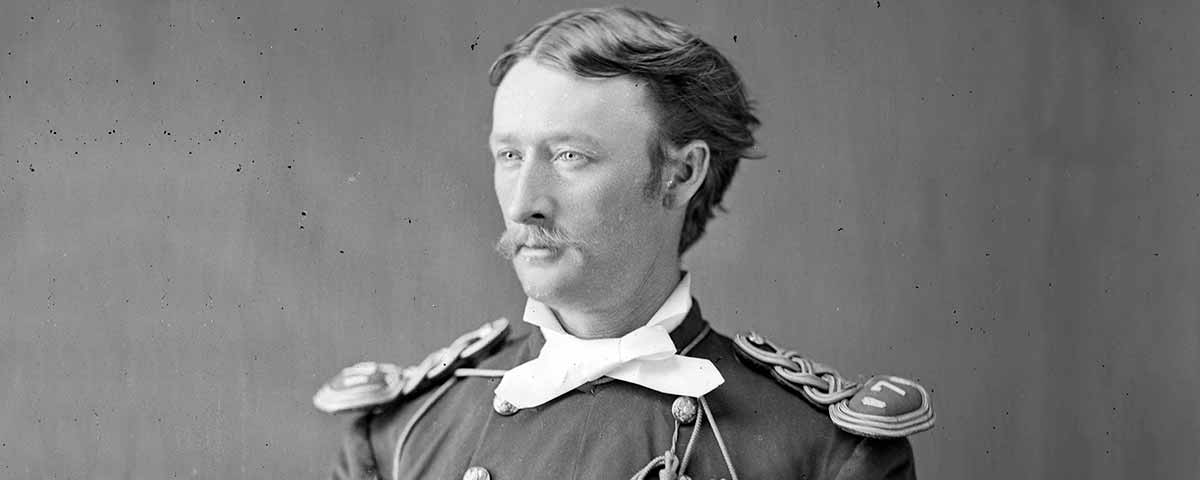George got the headlines, but Tom often outdid him on the battlefield
Although it seemed he would always be relegated to serve in the giant shadow cast by his famous—and much more calculatedly ostentatious—brother George, Thomas Ward Custer actually succeeded in upstaging his older sibling on several Civil War battlefields. George had a three-month head start on Tom, entering the war at the First Battle of Bull Run in July 1861, and then using his high-level connections to Maj. Gen. George B. McClellan and others to manipulate his way to the top of the Union Army cavalry hierarchy. Tom enlisted in September 1861 and served reliably—without the headlines—before finally outdoing George in grand fashion during the Appomattox Campaign. By valiantly capturing two heavily defended Confederate battle flags at Namozine Church on April 3, 1865, and then Sailor’s Creek on April 6, he was awarded Medals of Honor—in that era the only gallantry award the U.S. Army was able to present. Even then, Tom remained doomed to live and die second fiddle to George. The two perished together fighting at Little Bighorn on June 25, 1876, but the “Custer’s Last Stand” label stamped on that inglorious defeat refers exclusively to George Armstrong Custer.
Thomas Custer was born in New Rumley, Ohio, on March 15, 1845, nearly six years after George, whom Tom preferred to call “Armstrong.” Just 16 in September 1861, Tom received his parents’ permission to enlist in the 21st Ohio Infantry. George had graduated from West Point in the war-accelerated Class of June 1861, emerging—just barely, with a record total of 726 demerits—as a cavalry branch officer. Tom, meanwhile, began as a private and had to earn his way up the ladder of rank one hard rung at a time.
During the Civil War, battle flags were of the utmost importance in battlefield communications and signaling, and they played a pivotal role in rallying the morale of the soldiers in the ranks of both sides. At a time when “Rally ’round the flag!” was, quite literally, a command and represented much more than a mere catchphrase, regimental flags served as a source of fierce pride to soldiers and officers alike, and these banners inspired men to perform beyond their own expectations. As such, they were zealously protected in battle, with the flag-bearer revered and often protected unto death by his mates. The capture of an enemy battle flag represented one of the most daunting challenges of Civil War combat, requiring boundless initiative, extraordinary courage and extreme luck.
Tom was an officer on the staff of Colonel Henry Capehart of the Army of the Potomac’s 3rd Cavalry Division when he captured a 2nd North Carolina Cavalry flag at Namozine Church, at the outset of the Appomattox Campaign. Reportedly, he leapt his horse over a barricade, tore the flag out of the hands of a standard- bearer, and demanded the immediate surrender of the Rebels around him. Eleven soldiers and three officers complied. Although his horse was shot, Tom miraculously emerged without a scratch.

After the battle, a justifiably proud Brevet Maj. Gen. George Custer, commanding the 3rd Division, wrote to his wife, Libbie: “God has blessed us with victory….Tom in the most gallant manner…captured the battle flag of the Second North Carolina Cavalry.” He then presciently predicted Tom would receive a Medal of Honor.
Tom repeated the feat at Sailor’s Creek three days later, charging on his horse while under heavy fire against entrenched infantry of Lt. Gen. Richard Ewell’s Corps and engaging several Rebels with only his pistol. Upon seeing a standard-bearer whose colors were serving as a rallying point, he redirected his efforts. As Colonel Capeheart wrote to Libbie Custer:
“Having crossed the line of temporary works in the flank road, we were confronted by a supporting line. It was from the second line that he wrested the colors, single-handed, and only a few paces to my right. As he approached the colors he received a shot in the face which knocked him back on his horse, but in a moment he was upright in his saddle. Reaching out his right arm, he grasped the flag while the color bearer reeled. The bullet from Tom’s revolver must have pierced his heart. As he was falling, Captain Custer wrenched the standard from his grasp and bore it away in triumph.”
In his youthful exuberance, the wounded Tom galloped back toward his own lines waving his trophy. An officer of the 3rd New Jersey Cavalry—concerned that Tom might be mistaken for an advancing Rebel—shouted, “For God’s sake, Tom, furl that flag or they’ll fire on you!” Still waving the enemy colors, and bleeding copiously from his wound, Tom rode up to his brother and commanding officer, shouting, “Armstrong, the damned Rebels shot me, but I’ve got my flag!”
With Tom preparing to reenter the fray, his shaken older brother ordered him to report immediately to the field surgeon. When Tom gave every indication of ignoring the command, George ordered him arrested and conveyed under guard to the field hospital. The wound was bloody but proved not fatal, the bullet having traversed from his lower jaw to his ear without severing any major arteries. It was serious enough, however, to require further treatment, and it would leave Tom with a noticeable scar for the remainder of his short life.
For Tom Custer, the war was over, a scant three days before Lee’s final surrender at Appomattox. By war’s end, he had been promoted to brevet lieutenant colonel, and his Sailor’s Creek heroics led to a second Medal of Honor. He was the first American soldier to receive the medal twice, and one of only 19 in the nation’s history.
Remaining in the Army, Tom went on to serve with distinction in the West. His service included the Indian Wars’ 1868 Washita Campaign (in which he was again wounded), and in the 1873 Yellowstone and 1874 Black Hills expeditions. He was well liked, and highly respected by his men. By all reports, the hard-drinking officer played as enthusiastically as he soldiered, carousing with sporting women, ardently hunting buffalo and antelope, and keeping such exotic creatures as rattlesnakes and wolves as pets. Tom was instrumental in the arrest of Sioux Chief Rain-in-the-Face (who later claimed to have cut out Tom’s heart at Little Bighorn in revenge), and for reasons that have long since become obscure, conducted a long-standing feud with former cavalry scout, sometime lawman, and much-feared “pistoleer” James Butler “Wild Bill” Hickok, widely acclaimed the most dangerous man on the frontier.
In May 1876, when Lt. Col. George Armstrong Custer led the 7th Cavalry out of Fort Lincoln, Dakota Territory, on its fateful march toward Little Bighorn, Captain Thomas Ward Custer—though nominally in command of the regiment’s C Company—rode beside George as his aide-de-camp, still in his big brother’s shadow.
Ron Soodalter is a regular contributor to America’s Civil War.





